Learning from the practice of DnA and architect Xu Tiantian, participants are invited to discover how various local materials from across the coastal ecosystem of Meizhou Island, are sourced, studied, and implemented into an architectural project. From bamboo to mangroves to oyster shells, this workshop is an invitation to explore how materials with diverse(...)
25 June 2024 to 17 November 2024
Material Workshop: In Low Tide
Actions:
Description:
Learning from the practice of DnA and architect Xu Tiantian, participants are invited to discover how various local materials from across the coastal ecosystem of Meizhou Island, are sourced, studied, and implemented into an architectural project. From bamboo to mangroves to oyster shells, this workshop is an invitation to explore how materials with diverse(...)
2016 Visiting Scholar Cara Rachele presents her research: This lecture investigates the explosion of detail drawings in the Renaissance. It connects the emergence of the detail in the sixteenth century as a canonical drawing type with the evocation of the material antique. The organic evolution of the detail drawing method can be seen in the sketchbooks of everyday(...)
11 August 2016, 6pm
Visiting Scholar Seminar: Cara Rachele
Actions:
Description:
2016 Visiting Scholar Cara Rachele presents her research: This lecture investigates the explosion of detail drawings in the Renaissance. It connects the emergence of the detail in the sixteenth century as a canonical drawing type with the evocation of the material antique. The organic evolution of the detail drawing method can be seen in the sketchbooks of everyday(...)
archives
Level of archival description:
Fonds
AP113
Synopsis:
The Illinois Institute of Technology (IIT) - New Campus Center Competition fonds documents the projects of 4 of the 5 finalists (Eisenman, Hadid, Jahn/Sobek and Sejima/Nishizawa) of the international competition Richard H. Driehaus Foundation Design Competition for the University’s New Campus Center held by the Illinois Institute of Technology (IIT) of Chicago in November 1996. The fonds contains 20 presentation panels and 7 models. _____________________ Le Illinois Institute of Technology (IIT) - New Campus Center Competition fonds documentent les projets soumis par 4 des 5 finalistes (Eisenman, Hadid, Jahn/Sobek et Sejima/Nishizawa) au concours international Richard H. Driehaus Foundation Design Competition for the University’s New Campus Center lancé par l’Illinois Institute of Technology (IIT) de Chicago en novembre 1996. Le fonds contient 20 panneaux de présentation et 7 maquettes.
[1997]-1998
IIT - New Campus Center Competition fonds
Actions:
AP113
Synopsis:
The Illinois Institute of Technology (IIT) - New Campus Center Competition fonds documents the projects of 4 of the 5 finalists (Eisenman, Hadid, Jahn/Sobek and Sejima/Nishizawa) of the international competition Richard H. Driehaus Foundation Design Competition for the University’s New Campus Center held by the Illinois Institute of Technology (IIT) of Chicago in November 1996. The fonds contains 20 presentation panels and 7 models. _____________________ Le Illinois Institute of Technology (IIT) - New Campus Center Competition fonds documentent les projets soumis par 4 des 5 finalistes (Eisenman, Hadid, Jahn/Sobek et Sejima/Nishizawa) au concours international Richard H. Driehaus Foundation Design Competition for the University’s New Campus Center lancé par l’Illinois Institute of Technology (IIT) de Chicago en novembre 1996. Le fonds contient 20 panneaux de présentation et 7 maquettes.
archives
Level of archival description:
Fonds
[1997]-1998
Project
Maison Coloniale
AP066.S2.D19
Description:
Le dossier documente le projet de construction de la Maison Coloniale, une habitation associée à un atelier d'architecture et un hall d'exposition, situé au 4333 avenue Coloniale, à Montréal, Québec. Les matériaux utilisés pour réaliser cette construction sont le béton armé, l'acier et le bois. Le budget alloué pour ce projet était de 300 000$ et la superficie est de 340 mètres carrés. Aussi, le projet s'est mérité le Prix d'architecture du Gouverneur général du Canada. Le dossier contient des dessins, des reprographies, des photographies, des documents textuels, des maquettes et un négatif. Description du projet par l'architecte: "En concevant la Maison Coloniale, entre autres choses qui s'y trouvent inscrites, j'ai pensé à l'état des métiers. La solidarité qui nous lie est tellement ténue, les savoir-faire se déplacent, les langages s'autonomisent. Ici la structure de béton n'aura pour but structural que de survivre à sa peine : le squelette est dehors, qu'est-ce que cela veut nous dire? Partout la division, la séparation des éléments. La juxtaposition, la superposition et la répétition forment un langage dans le langage. Tout y est contact de points et de surface, d'appuis et d'ancrages. Le squelette est dehors, le corps est dedans. Qu'est-ce que cela veut nous dire? La Maison nous dit la nature de notre côtoiement. Elle nous rappelle nos liens possibles et nous apprend qu'à force de séparation, tout s'unit. Elle nous indique la distance qu'il nous reste à franchir pour se toucher et s'émouvoir. Elle est comme vous et moi, un peu résistante et prête à tout donner. Elle nous dit la convivialité et nous rappelle nos moyens d'humains. Elle nous rappelle que c'est nous qui l'avons faite!" Jacques Rousseau, "Éthique et tact", dans Architecture, éthique et technologie, édité par Louise Pelletier et Alberto Pérez-Gómez, McGill-Queen's University Press, Montréal, 1994, p. 137-150.
1986-1990
Maison Coloniale
Actions:
AP066.S2.D19
Description:
Le dossier documente le projet de construction de la Maison Coloniale, une habitation associée à un atelier d'architecture et un hall d'exposition, situé au 4333 avenue Coloniale, à Montréal, Québec. Les matériaux utilisés pour réaliser cette construction sont le béton armé, l'acier et le bois. Le budget alloué pour ce projet était de 300 000$ et la superficie est de 340 mètres carrés. Aussi, le projet s'est mérité le Prix d'architecture du Gouverneur général du Canada. Le dossier contient des dessins, des reprographies, des photographies, des documents textuels, des maquettes et un négatif. Description du projet par l'architecte: "En concevant la Maison Coloniale, entre autres choses qui s'y trouvent inscrites, j'ai pensé à l'état des métiers. La solidarité qui nous lie est tellement ténue, les savoir-faire se déplacent, les langages s'autonomisent. Ici la structure de béton n'aura pour but structural que de survivre à sa peine : le squelette est dehors, qu'est-ce que cela veut nous dire? Partout la division, la séparation des éléments. La juxtaposition, la superposition et la répétition forment un langage dans le langage. Tout y est contact de points et de surface, d'appuis et d'ancrages. Le squelette est dehors, le corps est dedans. Qu'est-ce que cela veut nous dire? La Maison nous dit la nature de notre côtoiement. Elle nous rappelle nos liens possibles et nous apprend qu'à force de séparation, tout s'unit. Elle nous indique la distance qu'il nous reste à franchir pour se toucher et s'émouvoir. Elle est comme vous et moi, un peu résistante et prête à tout donner. Elle nous dit la convivialité et nous rappelle nos moyens d'humains. Elle nous rappelle que c'est nous qui l'avons faite!" Jacques Rousseau, "Éthique et tact", dans Architecture, éthique et technologie, édité par Louise Pelletier et Alberto Pérez-Gómez, McGill-Queen's University Press, Montréal, 1994, p. 137-150.
Projet
1986-1990
archives
Level of archival description:
Fonds
Jean Michaud fonds
AP012
Synopsis:
Le Fonds Jean Michaud est constitué autour de 5 projets étudiants, 79 projets professionnels, 6 projets non identifiés, 13 projets réalisés par d'autres architectes, ainsi que divers documents visuels et textuels. Les projets de l'architecte sont répartis en 42 projets résidentiels, 4 pour les loisirs et l'animation sociale, 9 éducatifs, 7 commerciaux et administratifs, 3 industriels et manufacturiers, 1 pour le transport routier, 9 gouvernementales, 1 médical, 2 religieux et 1 projet d'aménagement urbain. Ces projets sont principalement concentrés dans quatre régions du Québec. Il y en a 29 dans la région de Montréal (incluant Laval et Vaudreuil-Dorion; dont 17 à Montréal), 20 dans la région du Bas-Saint-Laurent et Gaspésie (11 à Rimouski), 12 en Montérégie (8 à Saint-Marc-sur-Richelieu) et 7 dans les Laurentides. Le fonds Jean Michaud comprend 1613 dessins, 959 reprographies, 271 documents photographiques, 43 documents graphiques, 1 maquette, ainsi que 2.805 m.l. de documents textuels. Ces documents ont été principalement produits entre 1950 et 1970.
1852, 1916, 1938-1981, surtout 1950-1974
Jean Michaud fonds
Actions:
AP012
Synopsis:
Le Fonds Jean Michaud est constitué autour de 5 projets étudiants, 79 projets professionnels, 6 projets non identifiés, 13 projets réalisés par d'autres architectes, ainsi que divers documents visuels et textuels. Les projets de l'architecte sont répartis en 42 projets résidentiels, 4 pour les loisirs et l'animation sociale, 9 éducatifs, 7 commerciaux et administratifs, 3 industriels et manufacturiers, 1 pour le transport routier, 9 gouvernementales, 1 médical, 2 religieux et 1 projet d'aménagement urbain. Ces projets sont principalement concentrés dans quatre régions du Québec. Il y en a 29 dans la région de Montréal (incluant Laval et Vaudreuil-Dorion; dont 17 à Montréal), 20 dans la région du Bas-Saint-Laurent et Gaspésie (11 à Rimouski), 12 en Montérégie (8 à Saint-Marc-sur-Richelieu) et 7 dans les Laurentides. Le fonds Jean Michaud comprend 1613 dessins, 959 reprographies, 271 documents photographiques, 43 documents graphiques, 1 maquette, ainsi que 2.805 m.l. de documents textuels. Ces documents ont été principalement produits entre 1950 et 1970.
archives
Level of archival description:
Fonds
1852, 1916, 1938-1981, surtout 1950-1974
The Toolkit for Today seminar is a constitutive part of the CCA Doctoral Students Program. We invite scholars to open up their toolboxes, share methodological challenges and approaches, and discuss the key concepts they work with on contemporary issues in architecture and related disciplines. In 2016, the Toolkit for Today focuses on “Keywords for the Environment,”(...)
27 June 2016 to 30 June 2016
Toolkit for Today: Keywords for the Environment
Actions:
Description:
The Toolkit for Today seminar is a constitutive part of the CCA Doctoral Students Program. We invite scholars to open up their toolboxes, share methodological challenges and approaches, and discuss the key concepts they work with on contemporary issues in architecture and related disciplines. In 2016, the Toolkit for Today focuses on “Keywords for the Environment,”(...)
The exhibition is an introduction to the work and life of Ernest Isbell Barott, a Montréal architect who practised from 1912 to 1966. The drawings and photographs in the exhibition are largely drawn from the Ernest Isbell Barott Archive at the CCA. Ernest Barott’s career coincided with a period of profound physical and social change in Canada, a time of national and civic(...)
1440 rue Sainte-Catherine Ouest
5 June 1985 to 6 September 1985
Ernest Isbell Barott, architecte/architect : une introduction/an introduction
Actions:
Description:
The exhibition is an introduction to the work and life of Ernest Isbell Barott, a Montréal architect who practised from 1912 to 1966. The drawings and photographs in the exhibition are largely drawn from the Ernest Isbell Barott Archive at the CCA. Ernest Barott’s career coincided with a period of profound physical and social change in Canada, a time of national and civic(...)
1440 rue Sainte-Catherine Ouest
The internet was invented as the ultimate standard; it is literally made of rules. Online content abides by some intentional and unintentional rules, and texture, smell, weight, flavour, and time are flattened together for the screen. Computers appear to instantaneously transform objects into images and meaning into information. 404 ERROR: The object is not online brings(...)
Octagonal gallery
11 November 2010 to 6 February 2011
404 ERROR: The object is not online
Actions:
Description:
The internet was invented as the ultimate standard; it is literally made of rules. Online content abides by some intentional and unintentional rules, and texture, smell, weight, flavour, and time are flattened together for the screen. Computers appear to instantaneously transform objects into images and meaning into information. 404 ERROR: The object is not online brings(...)
Octagonal gallery
Starting From... Windows
A window can be a void, an aperture, or a glass surface. Existing at the boundary between interior and exterior, windows admit light and air and frame views. The idea of the window, combined with advances in glass as a building material, became central to architectural experimentation during the modern period. This selection from the CCA collection presents a range of(...)
Hall cases
17 June 2010 to 27 September 2010
Starting From... Windows
Actions:
Description:
A window can be a void, an aperture, or a glass surface. Existing at the boundary between interior and exterior, windows admit light and air and frame views. The idea of the window, combined with advances in glass as a building material, became central to architectural experimentation during the modern period. This selection from the CCA collection presents a range of(...)
Hall cases
PH1998:0020:131
Description:
- The article "Iz materialov obsledovaniia arkhitektury zhilykh kompleksov." by V.S. Balikhin published in 'Problemy arkhitektury: Sbornik materialov/Problèmes d'architecture: Recueil des matèriaux [sic]' in 1936 contains views and brief descriptions of the positive and negative characteristics of some of the housing complexes constructed during the late 1920s - early 1930s in various cities and towns of Soviet Union. The projects discussed in the article include some of the projects represented in the group of photographs PH1998:0020:001-130, such as housing complexes Dangauerovka, Shabolovka, Dubrovka, Usachevka, and "Sharikopodshipnik" [Bearing] plant complex, all in Moscow, and the First and Second Blocks in Magnitogorsk.
architecture
published before 15 September 1936
Magazine article "Iz materialov obsledovaniia arkhitektury zhilykh kompleksov" [From materials of a survey of architecture of Housing complexes], Moscow
Actions:
PH1998:0020:131
Description:
- The article "Iz materialov obsledovaniia arkhitektury zhilykh kompleksov." by V.S. Balikhin published in 'Problemy arkhitektury: Sbornik materialov/Problèmes d'architecture: Recueil des matèriaux [sic]' in 1936 contains views and brief descriptions of the positive and negative characteristics of some of the housing complexes constructed during the late 1920s - early 1930s in various cities and towns of Soviet Union. The projects discussed in the article include some of the projects represented in the group of photographs PH1998:0020:001-130, such as housing complexes Dangauerovka, Shabolovka, Dubrovka, Usachevka, and "Sharikopodshipnik" [Bearing] plant complex, all in Moscow, and the First and Second Blocks in Magnitogorsk.
architecture
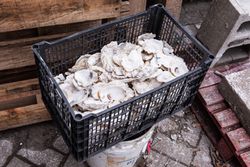
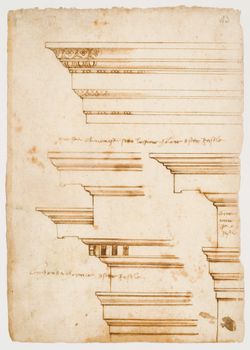
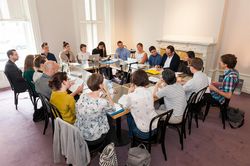

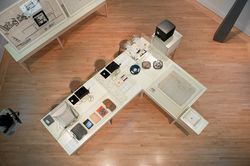
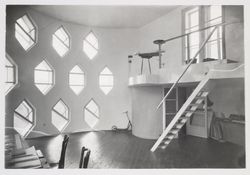
![Magazine article "Iz materialov obsledovaniia arkhitektury zhilykh kompleksov" [From materials of a survey of architecture of Housing complexes], Moscow](/img-collection/V-ouTPI5K0BG3phlE7EWyvrO3jY=/500x696/9806.jpg)